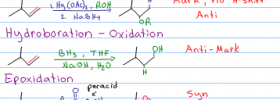 Alkene Reactions Series: Video 2
Alkene Reactions Series: Video 2
Alkene Hydrohalogenation is the reaction in which a pi bond is broken and a halogen added to the more substituted or ‘Markovnikov' position.
(Watch on YouTube: Hydrohalogenation. Click cc on the bottom right for video transcription.)
<– Watch Previous Video: Introduction to Alkene Reactions
–> Watch Next Video: Halogenation of Alkenes
This is Video 2 in the Alkene Reaction Mechanisms Video Series. Click HERE for the entire series.
Ready to test your skills? Try the Alkene Reactions Practice Quiz after watching the series!



hey Leah do you discuss what causes something to be more stable in a different video ?
since it is SN1, the product will be racemic?
thanks.
i want to ask about steoreochemistry
syn & anti
i want to understand it
I have been struggling with this for a long time and the way you explained it was so clear. Thank you so much!
it was nice explanation!! but I’m confused how do you assign primary or tertiary molecule ?
I get it now, the most stable carbocation (higher degrees) gets the halide
thank you
but what if 2 carbocation have the same stability as in both have 2 degrees or both have 3 degrees?
You’re welcome, Ben!
4 looks like orgo chem’s favorite number
4 bonds around carbon
F,Cl,Br,I
4 halides
Hey Leah, I am confused on how you marked a 3 carbocation on the cyclopentane but it looks like a 2 carbocation. I was slightly confused on that part. Just want some clarification.
Which point in the video?
When you put the point of your pencil on the tertiary carbocation she mentioned in the video you will see that Cabon is connecte to 2 carbon atom in cyclopentene and on carbon atom pointing outwards(primary carbon atom in the video)
Very helpful video. You’re #1!
Thank you Martrevez
Hey Leah, the video was really helpful but I’m confused about stereochemistry that results as part of alkene reactions. Do you discuss that in later videos? thanks!
I’ve covered that in a study hall video. Details: leah4sci.com/join
thank you so much , what’s the role of CCl4 reagent in the hydrohalogenation of double bond ??
You’re welcome. CCl4 is an inert solvent, meaning it provides the ‘solution’ for the reaction but doesn’t actually react
i love you videos , they are so helpfull. thank you so much
Thank you. Are you in a summer course or preparing for the Fall?
Ma’am why is it that why peroxide is added along with HBr the product is formed following anti mark rule
There is no peroxide in this reaction
Talesha, glad you found this video useful 🙂
Hope your final went well
I give you two thumbs up!! I just cannot believe how helpful your videos are. I sit in class for hours and understand nothing I watch your videos or a few mintues and I unersand it SMH!!!